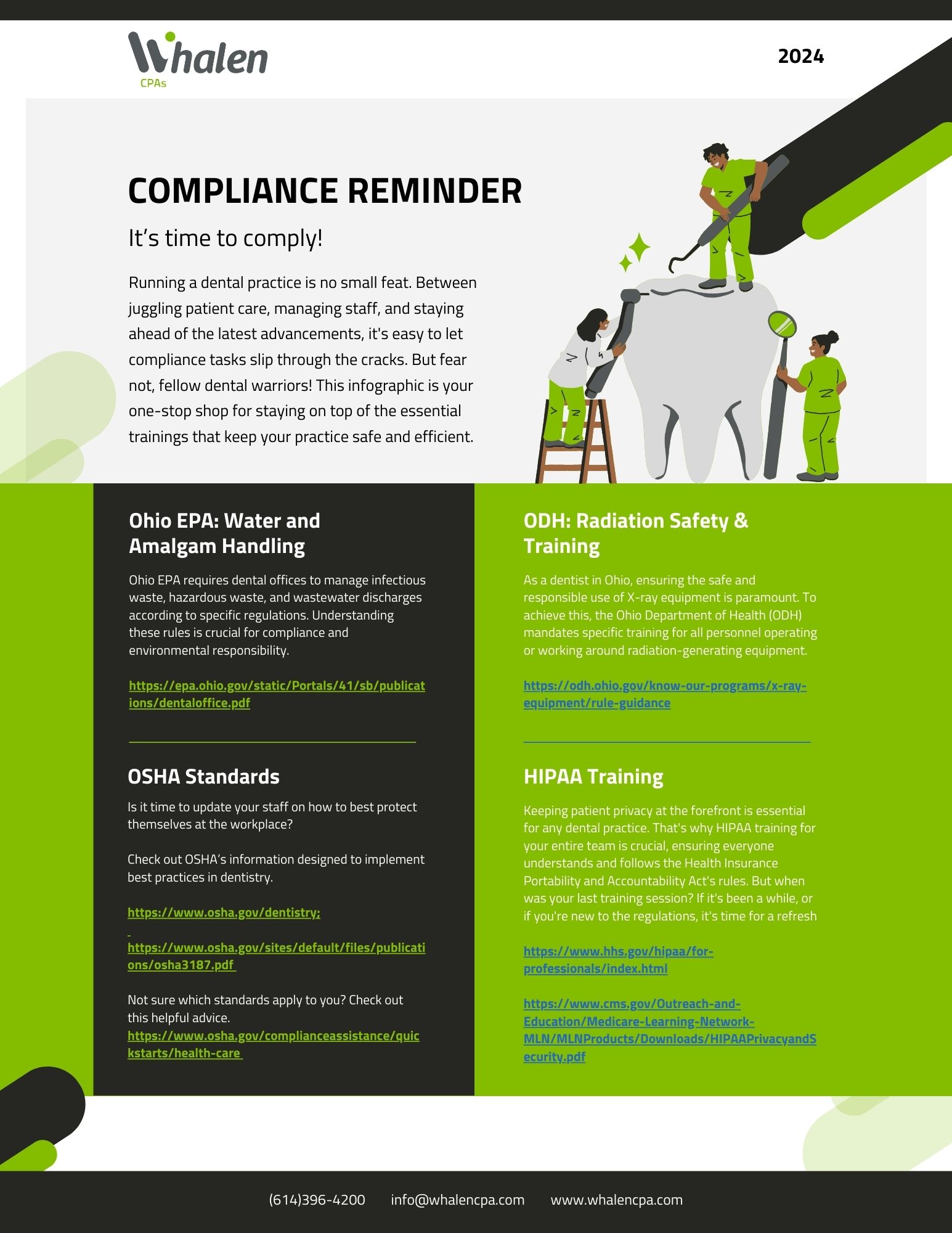Part 1: The Right Reasons
One of the most challenging decisions facing a seasoned practitioner is whether to add a new associate to the practice. Reasons abound for why dentists may entertain the idea. Often, doctors are motivated by thoughts of cutting back, increasing profits, or exiting the practice altogether.
Most dentists are hesitant to leap into adding an associate. In addition to the concerns that accompany upsetting the office’s status quo, there are unsettling questions to ponder, such as whether there is enough work for an extra dentist, how to distribute the workload, the monetary impact on the practice, and whether the patients and staff will bond with the newcomer. Fueled by their colleagues’ gruesome stories of bad associate relationships, it is no wonder doctors are wary of taking on the challenge of entering into an associateship agreement.
In this three-part series, you can explore your readiness for an associate and discover practical tips for setting up your office for a successful growth or transition cycle. In Part 1, you will learn how to evaluate your reasons for hiring an associate. Part 2 will provide practical metrics for ensuring it is the right time to hire, and Part 3 will explore tips for finding the right associate for your office.
It All Starts with Why
While there are many reasons practitioners begin to explore adding an associate to the office, these reasons broadly fall into three categories: capacity, growth, and succession.
Capacity
Capacity is the office’s ability to deliver timely and appropriate care to its current and potential patients. If patients cannot schedule within two or three weeks, the office has capacity issues that should motivate the practice owners to find out why. The inability to schedule patients promptly may be a symptom of poor operations. Alternatively, it may signal a need to add a provider. Diagnosing the real problem with the business is critical to enacting a satisfactory solution. Otherwise, dentists may try to solve capacity issues by adding an associate and later discover the real problem is poor policies and procedures.
When evaluating the cause of the capacity problem, practitioners should always begin by scrutinizing their office’s operations.
Operational Capacity. Diagnosing problems with operations begins with reviewing the office’s pace and procedures. Pace refers to the rate at which the staff performs daily tasks, such as operatory turn-around times, instrument processing times, checkout times, and scheduling efficiency. Poor systems, lack of automation, untrained or unprepared staff, weak oversight, deficient accountability, and other operations issues lead to unnecessarily long appointment times. As appointment after appointment runs behind due to inefficient processes or unprepared staff members, the wasted time begins to impact scheduling.
Before pursuing the addition of an associate dentist, ensure that these types of issues are not causative. If you uncover inefficiencies, take the time and effort to inform and train staff, establish accountability guidelines, and offer actionable feedback to staff members. Automating office procedures, such as insurance processing and billing tasks, is a reliable cure for procedural inefficiency. The correction for chairside inefficiency comes through increased training and oversight. After resolving the operational issues, owners should re-evaluate the office’s scheduling capacity. If the problem still exists, owners should determine if the problem is provider-related.
Provider Capacity. Provider capacity is the work each provider can perform during the work week. Since office inefficiencies are now corrected, owners are more confident that the scheduling issues are due to provider capacity. It is imperative to note that practitioners can create capacity issues because of their unique personal characteristics. All dentists operate differently regarding skill sets, work/life balance guidelines, and how many hours they can comfortably work each week. Consider your business from the perspective of your skills, work/life balance, and work constraints that characterize your practice, and determine if these elements contribute to the problem.
Skill Set. Some doctors enter their careers with additional residency training or continuing education experiences that add valuable skills to their practice. Doctors who enjoy performing advanced or complicated procedures may limit their availability to complete routine procedures, creating an office capacity problem. For example, suppose you operate a thriving implant practice or are heavily involved in sleep appliance therapy with a physician group. Treating these patients may use so much time that you cannot schedule more routine restorative procedures on other patients. Be aware that ignoring one group of patients’ needs for another is a misstep for any practice. Patients who have entrusted you with their oral healthcare deserve your best efforts to provide prompt treatment. If exercising your favorite skills is hampering scheduling, consider hiring an associate to provide routine care so you can focus on your niche.
Work/Life Balance. All dentists are unique in their quest for work/life balance. Sometimes, the dentist cannot practice full-time due to caregiver responsibilities for children or aging relatives, volunteerism, or other essential or non-negotiable commitments. Each doctor must balance the responsibilities of being an oral health care provider with their personal or life goals. Consider the patient population’s needs and assess how to maintain the optimal work/life balance without diminishing patient oversight. If you cannot see patients promptly, consider an associate to help you support your desired work/life balance and your patient’s best oral care.
Work Constraints. Some doctors may need to limit time at the office due to health concerns that make it difficult to stand or sit for prolonged periods. Others may suffer from ailments that require frequent breaks for nourishment, appointments, or self-care. These necessary constraints may negatively impact capacity. Suppose your work constraints make it impossible to carry a sufficient schedule alone. In that case, it may be time to add an associate.
Growth
Some dentists have excess finished or unfinished operatory space or building space. Maximizing the office’s productivity by utilizing the unused space seems logical. Other dentists may have dreams of opening satellite offices to serve patients in nearby communities. In either case, the office needs extra hands to realize these growth opportunities.
Careful business planning, including demographic studies and financial projections, is essential if owners decide to grow. The growth process will strain the current business due to the demands of planning and executing the plan. Prepare staff members for additional time constraints and scheduling difficulties. Dentists interested in these options must carefully weigh challenges, costs, benefits, and timing of growth. In Part 2 of this series, we will explore these elements in more detail.
Succession
A common reason for pursuing an associate relationship is due to an owner’s succession plan to transfer the practice. Some doctors seek associate relationships to identify and train a quality, like-minded dentist to assume business control in a specified timeframe. In this way, owners perceive they can slowly pass the reins of practice ownership to the associate. This arrangement helps the associate acclimate to the demands of the practice. It provides the staff and patients with access to the new owner during a timed transition. If this is the seller’s intent, it is wise to establish an open relationship from the outset. Avoid using an associateship as a “try before you buy” arrangement. Owners should ask the candidates about their expectations for the associateship and be ready to share their own. If both parties want to transfer the business, independently seek legal counsel to delineate equitable terms. Nothing could be more discouraging than to have unequal expectations from the association. Honest communication is foundational to trust building, and trust is essential to successful dentist-associate relationships. In Part 3 of the series, we will explore how to attract associates interested in purchasing the practice and suggest guidelines for a successful business transfer.
Key Takeaways
When considering adding an associate to your practice, consider the following:
- Begin examining associateship options by evaluating why you need an associate.
- Evaluate operational efficiency before assuming adding an associate will solve capacity issues.
- Assess if an associate is necessary due to provider capacity issues.
- Weigh challenges, costs, benefits, and timing when pursuing growth opportunities.
- Develop succession plans encompassing the seller’s desire to transfer ownership to the associate.
Adding an associate to your practice may seem daunting. Understanding your motivations for pursuing the relationship will enable you to proceed confidently through the process.






